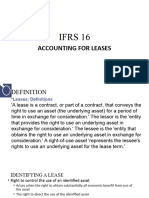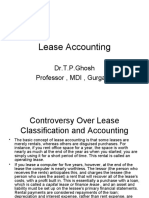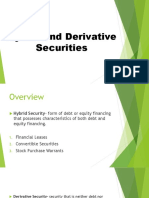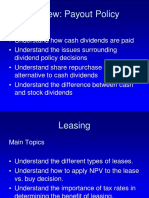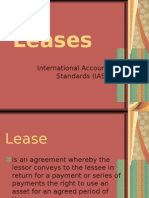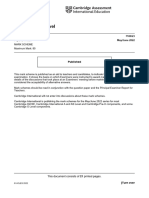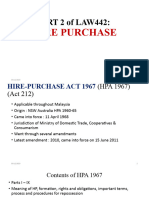0 ratings0% found this document useful (0 votes)
49 viewsLeasing
Leasing
Uploaded by
JHONLeasing and hire purchase are methods of financing assets. Leasing involves renting an asset from the owner (lessor) for a period of time, while hire purchase allows purchasing an asset by paying installments over time, with ownership transferring after the final payment. There are different types of leases such as financial leases, which transfer most risks and rewards of ownership to the lessee, and operating leases, which do not. Accounting treatment differs between lessors and lessees depending on the lease type. Hire purchase installments cover principal repayment, interest, and profit, while lease rentals may only include principal recovery and interest for financial leases.
Copyright:
© All Rights Reserved
Available Formats
Download as PPT, PDF, TXT or read online from Scribd
Leasing
Leasing
Uploaded by
JHON0 ratings0% found this document useful (0 votes)
49 views19 pagesLeasing and hire purchase are methods of financing assets. Leasing involves renting an asset from the owner (lessor) for a period of time, while hire purchase allows purchasing an asset by paying installments over time, with ownership transferring after the final payment. There are different types of leases such as financial leases, which transfer most risks and rewards of ownership to the lessee, and operating leases, which do not. Accounting treatment differs between lessors and lessees depending on the lease type. Hire purchase installments cover principal repayment, interest, and profit, while lease rentals may only include principal recovery and interest for financial leases.
Original Title
leasing.ppt
Copyright
© © All Rights Reserved
Available Formats
PPT, PDF, TXT or read online from Scribd
Share this document
Did you find this document useful?
Is this content inappropriate?
Leasing and hire purchase are methods of financing assets. Leasing involves renting an asset from the owner (lessor) for a period of time, while hire purchase allows purchasing an asset by paying installments over time, with ownership transferring after the final payment. There are different types of leases such as financial leases, which transfer most risks and rewards of ownership to the lessee, and operating leases, which do not. Accounting treatment differs between lessors and lessees depending on the lease type. Hire purchase installments cover principal repayment, interest, and profit, while lease rentals may only include principal recovery and interest for financial leases.
Copyright:
© All Rights Reserved
Available Formats
Download as PPT, PDF, TXT or read online from Scribd
Download as ppt, pdf, or txt
0 ratings0% found this document useful (0 votes)
49 views19 pagesLeasing
Leasing
Uploaded by
JHONLeasing and hire purchase are methods of financing assets. Leasing involves renting an asset from the owner (lessor) for a period of time, while hire purchase allows purchasing an asset by paying installments over time, with ownership transferring after the final payment. There are different types of leases such as financial leases, which transfer most risks and rewards of ownership to the lessee, and operating leases, which do not. Accounting treatment differs between lessors and lessees depending on the lease type. Hire purchase installments cover principal repayment, interest, and profit, while lease rentals may only include principal recovery and interest for financial leases.
Copyright:
© All Rights Reserved
Available Formats
Download as PPT, PDF, TXT or read online from Scribd
Download as ppt, pdf, or txt
You are on page 1of 19
Chapter 22
Leasing and Hire Purchase
Chapter Objectives
• To understand
• Lease financing and its role in economic
growth
• Lease structure
• Types of leases
• Hire purchase
• Instalment system
Lease Financing
• Contract between owner of an
asset(lessor) and the user of the
asset(lessee) under which the lessor gives
the right to the lessee to use the asset or
equipment for agreed period of time and
consideration called lease rental
• Depreciation can be claim by lessor not
lessee
Leasing and Economic Growth
• Complementary tool to bank loan
• Promotes investment in capital
equipments
• Leaves line of credit free for working
capital requirements
• Helps startups and small businesses to
grow
• Contributes to country’s infrastructure
growth
Types of Leases
• Financial Lease
• Operating Lease
• Sale and Leaseback
• Leverage leasing
• Close and open-ended lease
• Upfront and backend lease: More rentals in initial
years and less in later years of the contract in case of
upfront lease
• Percentage lease
• 3N lease
• Crossborder lease
Finance lease
• A finance lease or capital lease is a type of lease. It is a commercial
arrangement where:
• the lessee (customer or borrower) will select an asset (equipment, vehicle,
software);
• the lessor (finance company) will purchase that asset;
• the lessee will have use of that asset during the lease;
• the lessee will pay a series of rentals or installments for the use of that
asset;
• the lessor will recover a large part or all of the cost of the asset plus earn
interest from the rentals paid by the lessee;
• the lessee has the option to acquire ownership of the asset (e.g. paying the
last rental, or bargain option purchase price);
Financial lease
• The lease period covers at least 75% of the useful life of
the asset; or
• There is an option to buy the leased asset following the
lease expiration at a below-market rate; or
• Ownership of the leased asset shifts to the lessee
following the lease expiration; or
• The present value of the minimum lease payments totals
at least 90% of the fair value of the asset at the
beginning of the lease.
• If an examination of these criteria indicate
that a leased asset is a capital lease, the
accounting for the lease is comprised of
the following activities
Accounting in books of lessee
• Initial recordation. Calculate the present value of all
lease payments ; this will be the recorded cost of the
asset (capitalisation of asset).Future rental payment
as liability in balance sheet. Record the amount as a
debit to the appropriate fixed asset account, and a
credit to the capital lease liability account. For
example, if the present value of all lease payments
for a production machine is $100,000, record it as a
debit of $100,000 to the production equipment
account and a credit of $100,000 to the capital lease
liability account.
• Lease payments. As the company receives lease
invoices from the lessor, record a portion of each invoice
as interest expense and use the remainder to reduce the
balance in the capital lease liability account. Eventually,
this means that the balance in the capital lease liability
account should be brought down to zero. For example, if
a lease payment were for a total of $1,000 and $120 of
that amount were for interest expense, then the entry
would be a debit of $880 to the capital lease liability
account, a debit of $120 to the interest expense account,
and a credit of $1,000 to the accounts payable account.
• Depreciation. Since an asset recorded through a capital
lease is essentially no different from any other fixed
asset, it must be depreciated in the normal manner,
where periodic depreciation is based on a combination of
the recorded asset cost, anysalvage value, and its useful
life. For example, if an asset has a cost of $100,000, no
expected salvage value, and a 10-year useful life, the
annual depreciation entry for it will be a debit of $10,000
to the depreciation expense account and a credit to
theaccumulated depreciation account.
• Total lease payment is divided into
parts:Financial charges will be treat as
expense in P/L account and principal
amount will be deducted from liability side
of balance sheet.
Accounting for lessor under
Financial lease
• Leased asset will be shown as receivable
in the books of lessor.
• Lease payment receivable as repayment
of principal
Operating lease
• An operating lease is a lease whose term is
short compared to the useful life of the asset or
piece of equipment (an airliner, a ship, etc.)
being leased. An operating lease is commonly
used to acquire equipment on a relatively short-
term basis. Thus, for example, an aircraft which
has an economic life of 25 years may be leased
to an airline for 5 years on an operating lease.
Accounting for lessee under
Operating lease
• Lease rentals under operating lease will
be treated as an expense in P/L account.
Accounting for lessor under
Operating lease
• Assets as fixed asset in balance sheet and
depreciation will be charged
• Lease rentals will be treated as income in
P/L account.
Hire Purchase
• A contract whereby the owner of the
goods lets them on hire to hire purchaser
on payment of rent, tobe paid in
instalments and the title in goods will pass
to the hirer on the payment of last
instalment
Difference between Lease and Hire
Purchase
• Lease transaction is a commercial arrangement, whereby an equipment owner or
manufacturer conveys to the equipment user the right to use the equipment in return
for rental.Hire purchase is a type of installment credit under which the hire purchaser
agrees to take the goods on hire at a stated rental, which is inclusive of the
repayment of principal as well as interest, with an option to purchase.Option to user
• Except the Finance lease. no option is provided to the lessee (user) to purchase the
goods.The person becomes owner of the asset after paying the last installment
Nature of expenditureLease rentals paid by the lessee are entirely revenue
expenditure of the lessee.Only interest element included in the Hire Purchase
installments is revenue expenditure in nature.
• Components:Lease rentals comprise of two elements (1) finance charge and (2)
capital recovery.Hire Purchase installments comprise of three elements (1) normal
trading profit (2) finance charge and (3) recovery of cost of goods/assets.
• Depreciation: Lessor can claim for the depreciation Hire purchaser can claim for the
depreciation
• Tax Benefit:In lease agreement, Lessor can claim depreciation and the lessee can
claim the maintenance and rentals from taxable income. Higher purchaser can claim
for depreciation and interest payment from the taxable income where as the seller
can claim for the interest on borrowed fund for purchasing assets.
You might also like
- Leasing N Hire Purchase (MOFS)Document13 pagesLeasing N Hire Purchase (MOFS)Vanshita SethNo ratings yet
- IFRS 16 LeasesDocument42 pagesIFRS 16 LeaseskrishnaguptaNo ratings yet
- Lease Accounting: Professor, I.M TiwariDocument20 pagesLease Accounting: Professor, I.M TiwariEr Swati NagalNo ratings yet
- Lease Accounting: Dr.T.P.Ghosh Professor, MDI, GurgaonDocument20 pagesLease Accounting: Dr.T.P.Ghosh Professor, MDI, Gurgaonkmillat100% (1)
- LEASESDocument46 pagesLEASESdantekailey9No ratings yet
- Intro To Leasing NoteDocument5 pagesIntro To Leasing NoteZain FaheemNo ratings yet
- Banking and NBFC - Module 5 NBFC Produtcs Lending BasedDocument89 pagesBanking and NBFC - Module 5 NBFC Produtcs Lending Basednandhakumark152No ratings yet
- Finama LeasingDocument34 pagesFinama LeasingLoren Rosaria100% (1)
- Lessor+Leasee+AccountingDocument3 pagesLessor+Leasee+AccountingdarkkithekaknightNo ratings yet
- Chapter 12. LeasesDocument24 pagesChapter 12. LeasesАйбар КарабековNo ratings yet
- Topic 5 Cop Fin NotesDocument28 pagesTopic 5 Cop Fin Notescliffton malcolm tshumaNo ratings yet
- Leases Slides - FinalDocument34 pagesLeases Slides - FinalAnonymous n3n1Ae100% (1)
- Leasing: Lease Financing Is Based On The Observation Made by Donald B. GrantDocument18 pagesLeasing: Lease Financing Is Based On The Observation Made by Donald B. GrantyogeshNo ratings yet
- Leasing & Its Types by Saket RathiDocument2 pagesLeasing & Its Types by Saket RathisaketrathiNo ratings yet
- Leasing, Hire Purchase and Venture Capital: Submitted By: Submitted TODocument61 pagesLeasing, Hire Purchase and Venture Capital: Submitted By: Submitted TOaqas_khan100% (1)
- Lease Financing Test 2Document49 pagesLease Financing Test 2manojpatilpranavNo ratings yet
- LeasingDocument33 pagesLeasingmeftahul arnobNo ratings yet
- Hire Purchase and LeasingDocument33 pagesHire Purchase and LeasingSoumendra RoyNo ratings yet
- ACCOUNTING FOR LEASES NotesDocument5 pagesACCOUNTING FOR LEASES NotesMutheu MuetiNo ratings yet
- Lease PDFDocument13 pagesLease PDFAsma HatamNo ratings yet
- Khushigadiya LeasingDocument10 pagesKhushigadiya Leasingkilling machineNo ratings yet
- Lease Vs Hire FM FinalDocument60 pagesLease Vs Hire FM FinalTanmay MehtaNo ratings yet
- Unit 2 - Fund Based FSSDocument27 pagesUnit 2 - Fund Based FSSgowrirao496No ratings yet
- CF Session 19-Lease FinancingDocument9 pagesCF Session 19-Lease FinancingRitika MehtaNo ratings yet
- Lease and Hire PurchaseDocument26 pagesLease and Hire PurchaseMahesh RangaswamyNo ratings yet
- Marketing of Financial Services Leasing 1 PPT FinalDocument17 pagesMarketing of Financial Services Leasing 1 PPT Finaljohn_muellorNo ratings yet
- A667849305 22264 20 2019 LeaseDocument26 pagesA667849305 22264 20 2019 LeaseChinmai SaiNo ratings yet
- Ind - As 17Document22 pagesInd - As 17ambarishNo ratings yet
- 202004021945300501vasudha Kumar Finance Management 1Document7 pages202004021945300501vasudha Kumar Finance Management 1StarboyNo ratings yet
- IAS 17/IFRS16 Accounting For Leases: MCA - FIA212Document30 pagesIAS 17/IFRS16 Accounting For Leases: MCA - FIA212Gift Malulu100% (1)
- Financial Leasing: Leasing Is A Significant Industry. in The Year 2004, It Accounted For OverDocument41 pagesFinancial Leasing: Leasing Is A Significant Industry. in The Year 2004, It Accounted For OverSouliman MuhammadNo ratings yet
- FACTORINGDocument12 pagesFACTORINGrulerhawkgamerNo ratings yet
- Leasing As Source of FinanceDocument12 pagesLeasing As Source of FinanceSumit SwamiNo ratings yet
- LeasingDocument13 pagesLeasinghassanali3181No ratings yet
- Leasing ACF PresentDocument22 pagesLeasing ACF PresentHameed WesabiNo ratings yet
- Term Paper # 1. Definition and Meaning of Lease FinancingDocument16 pagesTerm Paper # 1. Definition and Meaning of Lease FinancingAniket PuriNo ratings yet
- Financial Accounting: Session - 18: Accounting For Lease and Income TaxDocument16 pagesFinancial Accounting: Session - 18: Accounting For Lease and Income TaxSuraj KumarNo ratings yet
- LeasingDocument32 pagesLeasinglatikalatikaNo ratings yet
- By Otmar, B.A: Leasing PreparedDocument53 pagesBy Otmar, B.A: Leasing PreparedAnna Mwita100% (1)
- Lease and Intermediate Term Financing - Chapter 19Document34 pagesLease and Intermediate Term Financing - Chapter 19MASPAK100% (1)
- Unit II Leasing and Hire PurchaseDocument29 pagesUnit II Leasing and Hire PurchaseSreeju LakshmananNo ratings yet
- Leasing and Hire Purchase (Autosaved)Document72 pagesLeasing and Hire Purchase (Autosaved)medha_mehtaNo ratings yet
- Session 04 AlkDocument28 pagesSession 04 AlkAriyanto Bakti PNo ratings yet
- Leasing 1Document41 pagesLeasing 1Aaryan SinghNo ratings yet
- BFS - Leasing in IndiaDocument29 pagesBFS - Leasing in IndiaBhawana Choudhary50% (2)
- Tax and Accounting Aspects of LeasesDocument9 pagesTax and Accounting Aspects of LeasesJulie MarianNo ratings yet
- Fundamentals of LeasingDocument27 pagesFundamentals of LeasingMehedi HasanNo ratings yet
- LeasingDocument44 pagesLeasingmeenakshi383No ratings yet
- IFRS 16 ACFR NOTES , SCENARIO workingDocument17 pagesIFRS 16 ACFR NOTES , SCENARIO workingFathima ShameehaNo ratings yet
- Lease Accounting TreatmentDocument15 pagesLease Accounting Treatmentkiane43No ratings yet
- MFS 5Document44 pagesMFS 5rahul raoNo ratings yet
- RMK Akm 2-CH 21Document14 pagesRMK Akm 2-CH 21Rio Capitano0% (1)
- Chapter 2-Lease & Hire PurchaseDocument42 pagesChapter 2-Lease & Hire Purchasebarbarian11No ratings yet
- Hybrid Financing: Preferred Stock, Leasing, Warrants, and ConvertiblesDocument165 pagesHybrid Financing: Preferred Stock, Leasing, Warrants, and ConvertiblesJewel Mae MercadoNo ratings yet
- Leases: International Accounting Standards (IAS 17)Document13 pagesLeases: International Accounting Standards (IAS 17)ashfakkadriNo ratings yet
- Presented By:-Mohit Nath Mba 3 SemDocument15 pagesPresented By:-Mohit Nath Mba 3 SemMohit NathNo ratings yet
- A Note On Comdisco - S Lease AccountingDocument25 pagesA Note On Comdisco - S Lease AccountingHussain HaidryNo ratings yet
- Theoretical and Regulatory Framework of Leasing: Management of Financial Services - MY KhanDocument28 pagesTheoretical and Regulatory Framework of Leasing: Management of Financial Services - MY KhanSuraj Rajpurohit67% (3)
- Comprehensive 1Document44 pagesComprehensive 1Alan RajNo ratings yet
- Co Profile BSNC Leasing LiquidationDocument4 pagesCo Profile BSNC Leasing LiquidationthivvvNo ratings yet
- BBA AccountingDocument71 pagesBBA Accountingkhansha ComputersNo ratings yet
- Cambridge O Level: Commerce 7100/23 May/June 2022Document21 pagesCambridge O Level: Commerce 7100/23 May/June 2022ahmedmujtabaNo ratings yet
- HP 1 (Auto-Saved)Document85 pagesHP 1 (Auto-Saved)2023630936No ratings yet
- Definition of LandDocument43 pagesDefinition of Landmila100% (2)
- Sale of Goods ActDocument25 pagesSale of Goods ActfelixdelaliNo ratings yet
- Hire Purchase Sumathi AnkitaDocument18 pagesHire Purchase Sumathi Ankitasudharshanshervegar100% (1)
- Hire PurchaseDocument20 pagesHire Purchasehippop kNo ratings yet
- Lease, HP, Project FinanceDocument30 pagesLease, HP, Project FinanceSneha Ashok100% (1)
- Hire Purchase PDFDocument12 pagesHire Purchase PDFliamNo ratings yet
- More Direct. Less Hassle.: Finance, Servicing and Insurance From Volkswagen Financial ServicesDocument20 pagesMore Direct. Less Hassle.: Finance, Servicing and Insurance From Volkswagen Financial ServicesKornelija PadleckyteNo ratings yet
- Difference Between Contract of Indemnity and Contract of Guarantee: Ten Case AnalysisDocument11 pagesDifference Between Contract of Indemnity and Contract of Guarantee: Ten Case AnalysisSimranNo ratings yet
- Hire Purchase Agreement SbaDocument2 pagesHire Purchase Agreement SbaKacia Davis100% (1)
- Leasing & Hire PurchaseDocument8 pagesLeasing & Hire PurchaseImran AliNo ratings yet
- Faculty Law 2012 Session 2 Diploma Law240 231PDF 230105 082607Document9 pagesFaculty Law 2012 Session 2 Diploma Law240 231PDF 230105 0826072021202082No ratings yet
- Group Two, Commercial Law CatDocument12 pagesGroup Two, Commercial Law CatNimrod KipkoechNo ratings yet
- PriceListHirePurchase Normal3august2020Document69 pagesPriceListHirePurchase Normal3august2020waqar ahmadNo ratings yet
- Section 54 - SaleDocument7 pagesSection 54 - Saleishitasharma1741No ratings yet
- Lesson PlanDocument3 pagesLesson PlanaimanrslnNo ratings yet
- Hire Purchase AgreementDocument5 pagesHire Purchase Agreementmgaganav1825No ratings yet
- Hire Purchase and Installment Sale TransactionsDocument3 pagesHire Purchase and Installment Sale TransactionsGayathri NathanNo ratings yet
- Bangalore University BBMDocument68 pagesBangalore University BBMmadhutkNo ratings yet
- HP CurrentPriceListZero NormalDocument48 pagesHP CurrentPriceListZero NormalShahid IqbalNo ratings yet
- Maths 2Document5 pagesMaths 2nagashaprivah1994No ratings yet
- Sale and Hire-Purchase AgreementDocument8 pagesSale and Hire-Purchase AgreementBandana SinghNo ratings yet
- Manual Under Right To Information Act, 2005: Tamilnadu Small Industries Development Corporation LimitedDocument54 pagesManual Under Right To Information Act, 2005: Tamilnadu Small Industries Development Corporation LimitedsaravanaplusNo ratings yet
- HomeworkDocument4 pagesHomeworkMirza SaRaNo ratings yet
- MATHEMATICAL LITERACY 20 FEBRUARY 2018 14 September 2018Document88 pagesMATHEMATICAL LITERACY 20 FEBRUARY 2018 14 September 2018Sultry PapiNo ratings yet
- Rate Proportion % SpeedDocument9 pagesRate Proportion % SpeedNew Bright Way TuitionNo ratings yet

